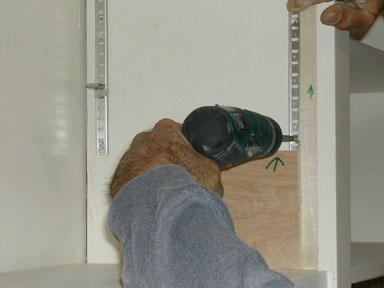
 by Steven D. Johnson
by Steven D. Johnson
Racine, Wisconsin
(Page 2 of 5)
Previous Page
1
2
3
4
5
Next Page
Measuring & Marking – "Assume"ing makes an...well, you know the saying
For many of us, measuring and marking for our work is second nature. We work quickly,
efficiently, and with the degree of accuracy the particular job requires. For others, what seems
second nature to us can be an epiphany.
My friend was helping me a couple of weekends ago, and asked what needed to be done. The old
kitchen cabinets used metal standards and clips for the shelves. The cabinets have been painted,
and the finish has cured for over a week. I asked him to remount the standards. My only advice,
"Just get them level." I left to work on another project.
An hour or so later, I came back, and my friend was contorted into an unusual shape, struggling
with a tape measure to mark tiny dots on the inside cabinet walls where the shelf standards would be
mounted. I quietly cursed myself for making assumptions, and took him out to the garage where we
fished a uniform thickness stick of poplar and a 4 inch by 6 inch block of plywood from the scrap
pile. I then showed him how to put the block on the cabinet bottom, the stick in the corner, and
push the shelf standard into both and drive the screws. Using the "technique" he mounted all the
shelf standards in less than thirty minutes and was back asking me what to do next. Later, when we
took a coffee break, he couldn't stop talking about his experience. "That was amazing!" "How do
you know how to do stuff like that?" "I never would have thought of that!"

|
Figure 5 - A block of plywood and a piece of poplar
used as "story sticks" to mount
shelf standards
|
It seems so simple, yet I still see woodworkers carefully measuring to cut four, or eight, or
more boards to length to make drawers, when they could easily set a stop on their saw and cut every
one to the same length without any measuring. I have seen people spend thirty minutes measuring for
a row of holes, when a shop-made jig could be made in five minutes and every hole would be perfectly
spaced...in minutes. When I framed a couple of houses, I used a felt marker and marked out 16-inch
on-center stud marks on the plywood floor decking. Every wall we built was built over those marks.
No need to measure again, except for window and door openings. I use a story stick with two heights
marked to mount electrical boxes and a small block of wood with a 3/16 inch rabbet to set the reveal
on window and door casing.
It was not comfortable, or accurate, for my friend to think I am some kind of genius, so I asked
him about his experiences as a manager in a manufacturing plant. I asked him to tell me about
changes he made on the assembly line to speed things up. He recalled a story about the process
engineers who designed the workflow for one particularly difficult job as a one-person function. It
clearly was a bottleneck on the line, so my friend gave some additional light assembly functions to
other workers and freed up one additional person, and re-engineered the problem assembly into a
two-person job. His throughput numbers increased dramatically and the number of units rejected for
quality reasons went to near zero. In fact, his re-engineering of the job was so successful, it got
noticed and people from the corporate headquarters came to see what was going on. Instead of being
cheered for his creativity, unfortunately, he was ridiculed for changing the process the engineers
had devised.
The point is, though, that my friend devised a trick of his own to accomplish a given job more
quickly, more efficiently, and with higher quality. Something I could never have thought of. He
realized where I was heading with my questioning, and acknowledged that what is second nature to
some, is foreign language to others. The moral of this story? You will undoubtedly meet many new
and aspiring woodworkers in your lifetime. Don't make the mistake I made. Don't assume anything.
Take the time to show them your tricks. They will appreciate it.
(Page 2 of 5)
Previous Page
1
2
3
4
5
Next Page
Return to
Wood News
front page
